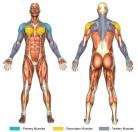Front Arm Raises (Cable)
- Set the pin of the pulley to the lowest setting.
- Secure a single-hand or straight-bar attachment to the cable machine.
- Position the body to face directly at the weight stack.
- Grab the attachment with an overhand (pronated) grip, stand up straight while keeping the knees slightly bent and the feet shoulder with apart.
- With a slight bend in the elbow(s), raise the attachment up and away until it becomes eye level, inhaling as you pull it up.
- Slowly lower the attachment down, exhaling throughout the motion.
- Repeat steps 5-6. If using the single-hand attachment, switch hands after a set is completed.
The use of cable machines are great for isolation exercises and front arm raises is not an exception. The cable machine enforces a strict lifting motion by minimizing the use of momentum to perform the exercise. To receive the greatest workout benefit, it is recommended to use the single-hand attachment which allows for self spotting. The best way to self spot on a cable exercise like this is to grab at or below the wrist of the hand holding the attachment.
Be sure to maintain a stance that keeps the shoulders directly facing the machine while lifting. This ensures the anterior deltoids remain the focus of the exercise. Movement of the feet or shoulders will reduce the emphasis them and draws the lateral deltoids more into focus.
At the peak lifting point, the trapezius is called into play with the teres major helping along the way. If one pauses for a moment with attachment eye level, the trapezius will be in use more than at any other point during the exercise.
Due to the intensity of front arm raises, they should not be performed with a heavy weight amount. The lifting motion involves part of the rotator cuff muscles (teres minor). A large amount of weight with the shoulder in a raised position may lead to injury and this is why you should not lift the attachment beyond eye level.





